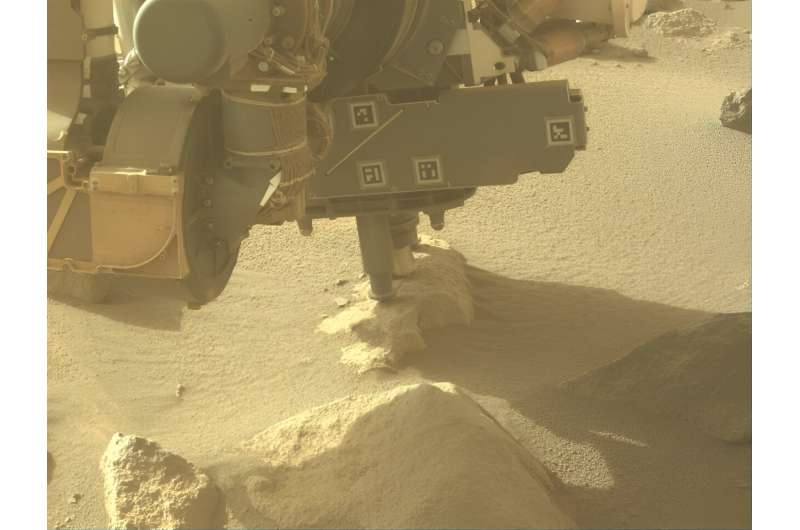This article has been reviewed according to Science X's editorial process and policies. Editors have highlighted the following attributes while ensuring the content's credibility:
fact-checked
trusted source
proofread
Carving into carbonates on Mars

This past week on Mars, Perseverance made a pit stop near Overlook Mountain to abrade a rock called Old Faithful Geyser. This target is situated within the Western side of the Margin Unit, an area around the upper edge of Jezero Crater that is astrobiologically interesting due to its abundant carbonate.
Carbonate-bearing rocks have been a major scientific focus throughout this campaign, which began with Perseverance entering the Eastern side of the Margin Unit on Sol 915 of the mission (1 sol = 1 day on Mars) in September of 2023, about 240 sols ago, then roving steadily Westward.
So far, Perseverance has collected 3 cores from this Unit, including Pelican Point on Sol 923, Lefroy Bay on Sol 942, and Comet Geyser on Sol 1088.
Proximity and remote science observations associated with each of these targets have all confirmed the presence of carbonate, but the grains and mineral assemblages in each rock are unique, which may indicate that carbonates in the Eastern and Western parts of the Margin have experienced different formation mechanisms and/or alteration histories.
In particular, the team is interested in understanding whether the carbonate-bearing rocks in the West formed through sedimentary, igneous, or volcaniclastic processes.
To investigate the origin of Western Margin Unit carbonates, the team decided to stop off at Old Faithful Geyser to conduct an opportunistic abrasion on Sol 1151, then measure the rock with the Planetary Instrument for X-ray Lithochemistry (PIXL), a proximity science instrument carried on the rover's arm.
PIXL maps elemental distributions across fine scales (each PIXL map is a few square millimeters), and the Wide Angle Topographic Sensor for Operations and eNgineering (WATSON) camera takes complementary images of rocks from a similar close-up scale to record rock textures, grain boundaries, and color distributions.
PIXL and WATSON will assess differences or similarities in composition in the Old Faithful Geyser abrasion, as compared to other targets across the Margin Unit, in hopes of better understanding how carbonates from East to West formed and transformed through time.
In addition to helping the team unravel the history of Jezero Crater's carbonates that record changes along the Margin, the observations at Old Faithful Geyser would provide additional context for the three collected Margin Unit core samples if they are brought back to Earth by Mars Sample Return (MSR) in the future.
Provided by NASA





















